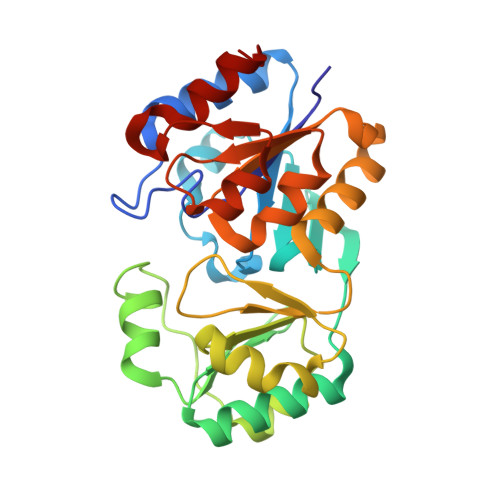The catalytic scaffold of the haloalkanoic acid dehalogenase enzyme superfamily acts as a mold for the trigonal bipyramidal transition state.
Lu, Z., Dunaway-Mariano, D., Allen, K.N.(2008) Proc Natl Acad Sci U S A 105: 5687-5692
- PubMed: 18398008
- DOI: https://doi.org/10.1073/pnas.0710800105
- Primary Citation of Related Structures:
2RAR, 2RAV, 2RB5, 2RBK - PubMed Abstract:
The evolution of new catalytic activities and specificities within an enzyme superfamily requires the exploration of sequence space for adaptation to a new substrate with retention of those elements required to stabilize key intermediates/transition states. Here, we propose that core residues in the large enzyme family, the haloalkanoic acid dehalogenase enzyme superfamily (HADSF) form a "mold" in which the trigonal bipyramidal transition states formed during phosphoryl transfer are stabilized by electrostatic forces. The vanadate complex of the hexose phosphate phosphatase BT4131 from Bacteroides thetaiotaomicron VPI-5482 (HPP) determined at 1.00 A resolution via X-ray crystallography assumes a trigonal bipyramidal coordination geometry with the nucleophilic Asp-8 and one oxygen ligand at the apical position. Remarkably, the tungstate in the complex determined to 1.03 A resolution assumes the same coordination geometry. The contribution of the general acid/base residue Asp-10 in the stabilization of the trigonal bipyramidal species via hydrogen-bond formation with the apical oxygen atom is evidenced by the 1.52 A structure of the D10A mutant bound to vanadate. This structure shows a collapse of the trigonal bipyramidal geometry with displacement of the water molecule formerly occupying the apical position. Furthermore, the 1.07 A resolution structure of the D10A mutant complexed with tungstate shows the tungstate to be in a typical "phosphate-like" tetrahedral configuration. The analysis of 12 liganded HADSF structures deposited in the protein data bank (PDB) identified stringently conserved elements that stabilize the trigonal bipyramidal transition states by engaging in favorable electrostatic interactions with the axial and equatorial atoms of the transferring phosphoryl group.
- Department of Physiology and Biophysics, Boston University School of Medicine, Boston, MA 02118-2394, USA.
Organizational Affiliation:


















